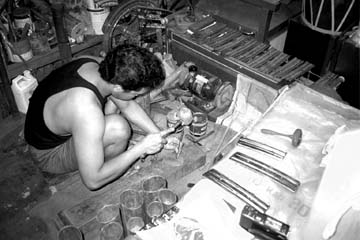
Note: I plan to add sound examples to this article in the future.
In the Fall of 1993, I was fortunate enough to travel to Indonesia on a Fulbright Senior Scholar Fellowship. The primary purpose of my visit was to teach Western music theory and composition at Institut Seni Indonesia (ISI), Yogyakarta, but I also intended to study traditional music as much as possible while there.
Though a composer by training, not an ethnomusicologist, I have studied quite a lot of the world's traditional music. Some of this music has had a great impact on my compositions. I have been most influenced by the music of Java and Bali, and this love of the region's music was the main impetus behind my Fulbright proposal.
I had intended to study the gender barung, a wonderfully mellow metallophone whose sound is my favorite in the Javanese gamelan orchestra. The gender consists of thin metal bars suspended over tube resonators and it is played with a padded, disc-headed mallet in each hand. It usually has fourteen keys and is pentatonic, though the tunings vary.
While I could not hope to become a truly competent performer in the traditional style in my six month stay, I hoped to learn enough to be able to compose for the instrument and perform my own compositions. I was fortunate enough to have the karawitan master Trustho as my teacher, and though I am still barely a beginner on the instrument, I did fulfill my goal of being able to perform my own music.
The gender barung traditionally plays variations of a repertoire of skeletal melodic patterns called cengkok.[1] The choice of the pattern depends mostly on the cadence tone of the phrase and the pathet (sometimes loosely translated as "mode") of the piece. I notated a great number of cengkok during my study, though this decidedly "Western" approach to study seemed sometimes to amuse my Javanese colleagues.
Another goal of mine during this stay was to commission a pair of gender tuned to my own tuning system for the performance of my own compositions. There are two types of tuning systems in Java: a heptatonic system with large and small steps called pelog and a pentatonic system with roughly equidistant steps called slendro, though neither exists in any standardized form. Instead, each gamelan is tuned to what is often a unique version of these tuning systems and thus has its own "world of sound." I decided on a just version of pelog and slendro that would be useful for my own composing, though truly just intervals are actually not common in traditional gamelan.
Through Jody Diamond's recommendation I met the gamelan maker Suhirdjan and his American wife, Joan Suyenaga. Both live in Yogyakarta and, as it happens, just a short walk from my house there. They were used to building instruments on commission for Americans, and Suhirdjan was glad to tune the instruments to my specifications. Figure 1 shows Suhirdjan at work on my slendro gender.

|
After discussing the matter with them, I decided to commission a pair of gender barung made from brass, rather than the traditional bronze. There were two main reasons for choosing the brass. First was the cost - brass is significantly cheaper, meaning that I had enough money left over to also commission a gong and a kempul. Even more important, brass is much more stable once it has been tuned. Bronze requires periodic "touching up," particularly in the first few years of the instrument's life. This is not a big problem for someone who lives close to a gamelan maker or tuner, but these craftspeople are rather scarce in the United States.
The difference between the brass and bronze is not merely that one is better than the other; each has its own unique timbre. If one's musical goal is to stay close to the aesthetics of the Javanese tradition, then clearly bronze is preferable. However, I have no such expectations, and I think these instruments have worked wonderfully for my purposes.
In order to give Suhirdjan the pitches that I wanted, I made a cassette tape. He has a variable-speed cassette player and asked that I put a 440 hz tone at the beginning, which he then matches to a tuning fork. I programmed the Macintosh Powerbook I had brought to produce the desired frequencies and recorded them onto cassette.[2] I also gave Joan a piece of paper showing the frequencies and the ratios for Suhirdjan's reference, but she later told me that they couldn't make heads nor tails of it.
I stressed to Suhirdjan that the octaves as well as the other intervals were to be absolutely beatless ("tampa ombak"). Traditionally the octaves in gamelan are slightly stretched or compressed a few hertz away from a 2/1 ratio to introduce a subtle beat (Hood 1966). Suhirdjan said that such a tuning with beatless (i.e. 2/1) octaves is called pleng. He later told me that pleng tunings exist but are uncommon in traditional gamelan. It seems that most players find them a little flat or lifeless. I tried to stress to him that the other intervals within the octave should be "pleng" as well, but he doesn't seem to listen to the beats of other intervals.
I was a little skeptical that he would be able to match the pitches from the cassette so precisely as to eliminate the beats. I personally wouldn't trust myself to tune to a tape or oscillator without cross-checking the beats between intervals. Therefore I asked Joan to please give me a call when he started work on my instruments. I hoped to be present to make sure everything was tuned to my satisfaction, though I was also interested in seeing the tuning process.
However, I then had to leave town to go lecture at other cities. When I returned, I found that Suhirdjan had plowed ahead with perfect confidence and was already finished tuning the slendro gender. As it turned out, though, my apprehension was unnecessary. I found the intervals dead on, and I have been completely satisfied since then. The slendro gender was finished in time for me to bring it home when I returned last spring. The pelog gender and the gongs were shipped later.
When I decided to write for traditional Indonesian instruments, I faced the familiar problem of how integrate these instruments, clearly designed for another type of music, with my own basically Western compositional heritage. At the one extreme of possible solutions, there are those, such as John Cage, who basically use the instruments the way that they would use any potential sound source. These composers may be interested in the sounds themselves and not particularly in the music of the Indonesian culture which produced the instruments. Certainly there is nothing wrong with this approach, and, after all, I have studied Western composition for many years and Javanese composition, by comparison, hardly at all.
On the other hand, there are those composers, such as Lou Harrison, who make the effort to learn the cultural and musical background to these instruments to the point that they can compose within many of the existing structures of traditional music. I find this approach comparable to an Indonesian musician who might to write for a Western orchestra and harmonies, say, but retain the influences of his or her own culture.
My own aesthetic inclinations, as well as my inexperience with composing traditional Indonesian music, led me towards a middle path. The influences of Javanese and Balinese cultures and music on my own composing are undeniable, but no one would mistake my composition for something traditional. I agree with Steve Reich's statement that one should imitate the structures, not the sounds, of non-Western music, though I think he meant the word "structures" in the most general sense (Reich 1974: 28). In other words, bring to your own composition the spirit behind the music that influences you, not just a shallow imitation of the sounds. As Reich said, "That's the old exoticism trip" (Reich 1974: 28).
The first work I composed using these instruments is Slendro Suite[3], which I actually began writing while still waiting in Yogya for the first gender to be finished. It is written for gender barung, gender panerus (the same instrument type, but pitched an octave higher), gong, and cello. The gender panerus part I have had to realize electronically for now.
The tuning of the slendro gender, while recognizably of a slendro type, is not a traditional Javanese tuning at all. Table 1 shows the slendro tuning I selected. (The five pitches in slendro are numbered 1, 2, 3, 5, 6. A dot above or below the number indicates an octave displacement.)
| Pitch | Ratio between steps | Cents between steps | Ratio relative to pitch 1 | Cents relative to pitch 1 | Frequency |
| 1 | 1/1 | 0.00 | 282.86 | ||
| 8/7 | 231.17 | ||||
| 2 | 8/7 | 231.17 | 323.27 | ||
| 7/6 | 266.87 | ||||
| 3 | 4/3 | 498.04 | 377.14 | ||
| 7/6 | 266.87 | ||||
| 5 | 14/9 | 764.91 | 440.00 | ||
| 8/7 | 231.17 | ||||
| 6 | 16/9 | 996.08 | 502.86 | ||
| 9/8 | 203.91 | ||||
| 1' | 2/1 | 1200.00 | 565.72 |
Suhirdjan characterized this tuning as a "general" slendro (Suhirdjan 1994). According to him, its only unusual qualities are its slightly high absolute pitch and that it is pleng, i.e. has beatless octaves. It is interesting to hear this characterization, because in the twenty-eight slendro gamelan whose tunings were measured by Surjodiningrat et. al. (1972), none had a step so small as a 9/8 (the smallest was 214 cents) and few steps were as large as a 7/6. However, the greater amount of variation in step size in my tuning did not seem significant enough to Suhirdjan to mention.
The high pitch is due to the 440 reference for pitch 5 that I chose, which matches pitch 5 in the pelog tuning system that I requested. (Of course I chose this interval to have a tuning reference with Western instruments.) This common note between the two tuning systems is called the tumbuk, and, while tumbuk 5 is found on traditional gamelan, Suhirdjan told me it was the "old" style. Tumbuk 6 is more common today. Suhirdjan attributed the high pitch to the tumbuk 5.
Compositionally, this tuning had several attractive aspects for me. I have long been enamored of septimal intervals (those with a 7 in the numerator or denominator), and I had seen (as others have) that the 8/7 interval is very close to most slendro steps. In fact, this tuning is the simplest superparticular pentatonic, and this set of intervals (though in a different order) has been used by Lou Harrison in his gamelan Si Darius and in the third movement of his work for orchestra and chorus Four Strict Songs.
This pentatonic contains two 3/2s, and in my case they lie between pitches 3 and !, and between pitches 6 and #. Because I write mainly harmonic music, I am very conscious of these relative intervals and their place in the harmonic series. These two 3/2s allowed for the formation of two "stable" modes, one with a tonic on pitch 3 and the other on pitch 6.
In Slendro Suite, the cello was retuned so that the D string was pitch 1, thus tuned down about 65 cents from equal-tempered D; and the G string was pitch 3, thus tuned down about 67 cents. The A string was equivalent to pitch 5 without retuning. The cello part was then notated in scordatura to the closest equally tempered pitch. Though I frequently wrote for open strings and natural harmonics to assist in the tuning, there were still plenty of notes that the cellist had to really work on getting in tune.
I wrote the gender part in Western notation primarily because I reasoned that the cellist (and myself) would be more fluent reading Western notation than the kepatihan (cipher) notation used in Java. Also, it was much easier to write some of the rhythms in Western notation. However, one drawback to Western notation is the appearance of skips implied by the superimposition of the Western staff over this tuning system, when the notes actually represent adjacent keys on the instrument. Figure 2 shows how the tuning of the gender was notated.

|
The first movement of Slendro Suite is a short prelude for solo gender barung. This movement serves to introduce the listeners to the world of this slendro tuning, much like a bawa or extended buka (short introductory sections for a singer or instrumentalist, respectively). This movement centers on pitch 5 and secondarily on pitch 1. I consider the modes on these pitches in my tuning somewhat unstable, but that does not mean unusable. In this case I deliberately chose that mode to keep the listener "off balance" before the second movement, which uses the stable mode based on pitch 6.
The second movement, an excerpt from which is shown in Figure 3, is a somewhat fast piece that features the genders. The cello mainly plays extended "background" pitches (rather like the sho of the Japanese gagaku orchestra).

|
The meter consists of irregular and constantly changing combinations of twos and threes and is therefore quite un-Javanese. The gong provides a type of interpunctuation, but it is also irregular. The movement still sounds very Javanese in spirit to me, though, and was largely inspired by the cengkok I learned from Trustho, especially the extended-length cengkok such as the one named petut gelut. As in Figure 3, these cengkok are often characterized by more rhythmically dense sections in which the gender barung player goes from playing two-part counterpoint to a rhythmically dense single line divided up between the two hands.
The third movement is in the mode with 3 as home pitch (the other stable mode). It is a slow movement featuring a rhapsodic melody played by the cello over an ostinato on the gender barung. The meter, while still not Javanese, is more regular, almost always consisting of a cycle of 6+6+6+7 x2. As I was not able to give up the Western idea of stress at the beginning of a phrase as opposed to the Javanese stress at the end, the gong is notated as striking at the beginning of each of these cycles. The middle of each of the cycles is articulated by a low pitch on the gender barung.
At a couple of key points in the movement the cello melody introduces the first pitches that lie outside the tuning system. I modeled these parts of the melody after the Javanese vocal practice known as barang miring, where the singer interpolates pitches outside the tuning system for an especially poignant effect (Figure 4).

|
Learning to write interesting pentatonic melodies was possibly the biggest challenge for me when writing this piece. Going back to twelve pitches per octave seems an embarrassment of riches, but I did just that in the following movement.
The fourth movement is a toccata for the cello. Aside from an occasional gong stroke, the cello is only accompanied by repetitive polyrhythmic patterns played by hitting and damping single gender keys. Despite the stability the gender tuning has to offer the pitch 3 tonality, a sudden turn to minor seconds and other non-slendro intervals effectively negates the feeling that the mode had in the previous movement. Like its counterpart, the second movement, this movement is based on irregular combinations of twos and threes.
The final movement is a short non-metrical rhapsody, like the first movement, but now in the stable mode on pitch 6. The song-like cello line is accompanied beginning half-way through by bowed genders (Figure 5).
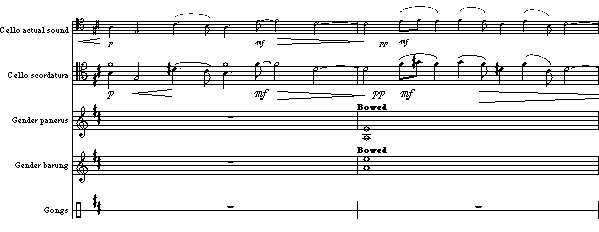
|
Bowing results in wonderfully ethereal sounds by using a string instrument bow (preferably a bass bow) on the edge of the gender key. This technique, now familiar to Western percussionists and some experimental composers in Indonesia, was still greeted with a general murmur of surprise when I did it in my farewell concert at ISI.
One problem remaining for Slendro Suite is how to make the piece performable by gender other than my own. The discovery that different slendros can have vastly different worlds of sound, in Lou Harrison's words, "brings up terrifying problems for a composer hoping that his own interval expression might be observed" (Harrison 1985: 113). I have tried playing parts of Slendro Suite on a variety of different gender and found that the different movements can retain much of their intended sound if the piece is suitably transposed. However, clearly explaining this transposition process in the score is also problematic.
Because the gender is a pentatonic instrument and pelog a heptatonic tuning system, there are normally two different pelog gender in a full gamelan. The pelog bem gender has pitches 1, 2, 3, 5, and 6 while the pelog barang gender has pitch 7 instead of 1. (Pitch 4 is not used in any gender.) Thus these two instruments differ in only a single pitch per octave.
Because this arrangement is relatively expensive, gamelan makers such as Suhirdjan have devised a method of exchanging keys without having to completely dismantle the suspension. These keys, called sorogan, Suhirdjan mounts on styrofoam blocks with nails through the suspension holes. While they do not ring quite as freely as normally suspended gender keys, they do sound for a long time and are almost indistinguishable from the other keys. Suhirdjan also includes blocks of wood with a string attached that one lowers into the resonating tube to change the resonating frequency, except in the lowest octave. The resonating frequency of the lowest pitches are changed by sliding a small metal aperture that changes the size of the hole on the end of the resonating tube.
On my pelog gender I asked for the ability to exchange key 1 for 7 (which is normal), but also pitch 5 for pitch 4. This exchange is not found in traditional gamelan - it is entirely based on my own desire to write for a certain tuning system. Actually, pitch 4 is never found on traditional gender, and, even if it were, it would be exchanged for pitch 3, not 5.
Thus there are four possible combinations on my pelog gender: 1, 2, 3, 5, 6 (pelog bem); 2, 3, 5, 6, 7 (pelog barang); 2, 3, 4, 6, 7; and 1, 2, 3, 4, 6 (which I did not specifically plan for, but have begun experimenting with). Because pitch 1 cannot be used at the same time as pitch 7 or pitch 4 at the same time as pitch 5, I have presented these tunings in separate tables:
| Pitch | Ratio between steps | Cents between steps | Ratio relative to pitch 1 | Cents relative to pitch 1 | Frequency |
| 1 | 1/1 | 0.00 | 293.33 | ||
| 8/7 | 231.17 | ||||
| 2 | 8/7 | 231.17 | 335.24 | ||
| 21/20 | 84.47 | ||||
| 3 | 6/5 | 315.64 | 352.00 | ||
| 5/4 | 386.31 | ||||
| 5 | 3/2 | 701.96 | 440.00 | ||
| 16/15 | 111.73 | ||||
| 6 | 8/5 | 813.69 | 469.33 | ||
| 5/4 | 386.31 | ||||
| ! | 2/1 | 1200.00 | 596.67 |
Suhirdjan characterized this pelog bem as "OK" ("agak enak") and found it reminiscent of Sundanese gamelan degung (though it is actually the pelog barang tuning that resembles degung). Compositionally, I had planned to use primarily the modes with a tonics on pitches 1 and 6, because the 3/2s above them allow for some stability. If I desire to use triads (though I don't necessarily write triadic music), several are available. The triad made up of pitches 1, 3, and 5 is a just minor triad; 6, !, # is a just major triad; and 1, 2, 5 is a triad with a septimal second (14:16:21).
| Pitch | Ratio between steps | Cents between steps | Ratio relative to pitch 7 | Cents relative to pitch 7 | Frequency |
| 7. | 1/1 | 0.00 | 268.19 | ||
| 5/4 | 386.31 | ||||
| 2 | 5/4 | 386.31 | 323.27 | ||
| 21/20 | 84.47 | ||||
| 3 | 21/16 | 470.78 | 377.14 | ||
| 5/4 | 386.31 | ||||
| 5 | 105/64 | 857.09 | 440.00 | ||
| 16/15 | 111.73 | ||||
| 6 | 7/4 | 986.83 | 469.33 | ||
| 8/7 | 231.17 | ||||
| 7 | 2/1 | 1200.00 | 536.38 |
Suhirdjan characterized this pelog barang as "rather foreign." He found pitch 2 too low and 7 too high in comparison with traditional tunings and thought that he could "feel a diatonic influence." This particular subset of pitches has a 3/2 only between pitches 6 and 3 - the rest of the modes are unstable for my purposes, but may still be musically useful.
The other pitch subset I planned to use consists of pitches 2, 3, 4, 6, 7. Naturally, this does not correspond to any traditional pitch set, as pitch 4 is not a regular member of any of the Javanese pathet. This tuning is shown in table 4.
| Pitch | Ratio between steps | Cents between steps | Ratio relative to pitch 7 | Cents relative to pitch 7 | Frequency |
| 7. | 1/1 | 0.00 | 268.19 | ||
| 5/4 | 386.31 | ||||
| 2 | 5/4 | 386.31 | 323.27 | ||
| 21/20 | 84.47 | ||||
| 3 | 21/16 | 470.78 | 377.14 | ||
| 8/7 | 231.17 | ||||
| 4 | 3/2 | 701.96 | 402.29 | ||
| 7/6 | 266.87 | ||||
| 6 | 7/4 | 986.83 | 469.33 | ||
| 8/7 | 231.17 | ||||
| 7 | 2/1 | 1200.00 | 536.38 |
This set is a suitable counterpart to that barang tuning, because, while I consider the barang tuning unstable, the addition of a 3/2 above pitch 7 makes this set very stable. Three of the four pitches above pitch 7 are low-order harmonics of pitch 7 (pitches 2, 4, and 6). Pitch 3 is also a harmonic of pitch 7, but further up the harmonic series (the twenty-first harmonic). Its primary function (as in pelog barang) is to give a stable mode on pitch 6. This tuning also serves as a kind of bridge to the slendro tuning because of its sequence of three septimal intervals separating pitches 3 through 7.
The counterpart to Slendro Suite is a piece called Pelog Partita, for gender barung, cello, viola, and percussion (including gong). It is also in three movements, but uses all three of the above tunings. The correspondence of the gamut of pitches to the notation is given below:

|
The first movement features the 2, 3, 4, 6, 7 tuning shown above. This tuning was in part inspired by the adzan, the Islamic call to prayer which is chanted over loudspeakers throughout Yogya beginning at 4 A.M., providing an early wake-up call during my first mornings there. The city is so quiet then that the air is filled only with the ghostly cacophony of simultaneous chanting over the loudspeakers of all the city's mosques. Though the adzan chanted near my house was clearly diatonic and never used the 7/4 above the tonic, this tuning clearly captures the spirit of those sounds for me.
I have tried to evoke this feeling in the movement, an unmetered, rhythmically free canon for the viola, gender, and a voice (optionally sung by the gender player) accompanied by drone pitches on the cello, the rolled gong, and vocal hums from the string players. In order to play this movement on a conventional gender, I suggest that the player simply leave out all pitch 4s from the gender part. They are covered by the other instruments and the overall impression of the many simultaneous chants is not significantly altered.
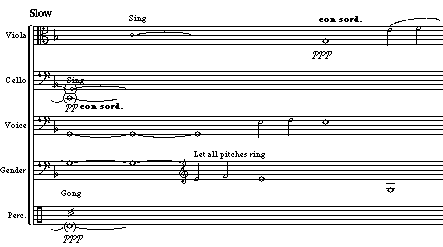
|
The second movement, also using the 2, 3, 4, 6, 7 tuning, though on a conventional gender it may be played in pelog barang tuning (to a somewhat different effect, of course). It prominently features tonal centers both on pitch 7 and pitch 6. The third movement features the percussionist playing tuned wine glasses or jaltarang (porcelain bowls). They are tuned to pitches 1, 2, 4, 5, 7: a set not found on the gender and which has no semitones. It is useful, therefore, as a major break away from the pelog sound of the other movements, and is closest to an anhemitonic pentatonic scale rather like those of China.
The fourth movement uses the pelog bem tuning, though the string instruments add several pitches outside of the tuning system, as they did in Slendro Suite. Closer to Balinese practice is the consistent use of polyrhythm in this movement.
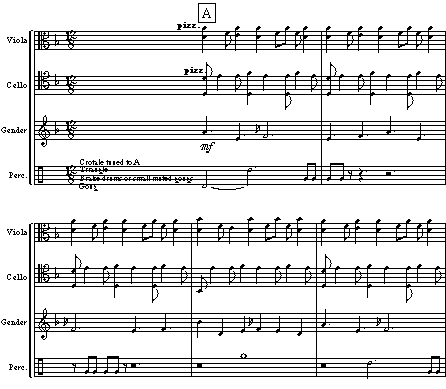
|
The last movement presents the pelog barang tuning, used to effect a rather restful conclusion. It features an ostinato that teeters between tonal centers on pitches 6 (stable because there is a 3/2 above it) and 3 (less stable because the fifth above it is a 32/21). It also figures a kind of octave heterophony inspired by the rebab (fiddle) part in Javanese gamelan (figure 9).

|
I intend to continue composing for and performing with these wonderful instruments and perhaps acquire more in the future. I hope that others, too, will continue to take advantage of the musical riches that Javanese and Balinese cultures have to offer Western composers.
Finally, I want to thank my teacher, Trustho; my host at ISI, Victor Ganap; Suhirdjan for his excellent craftsmanship and tuning; Joan Suyenaga for her invaluable help.
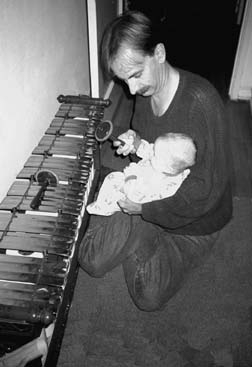
|
[2] I used the external command written by K. Romana Machado included in the Just Intonation Calculator software by Carter Scholz and Robert Rich, available from the Just Intonation Network.
[3] The score for Slendro Suite and Pelog Partita are available from the American Gamelan Institute, Box A-36 / Hanover, NH 03755.